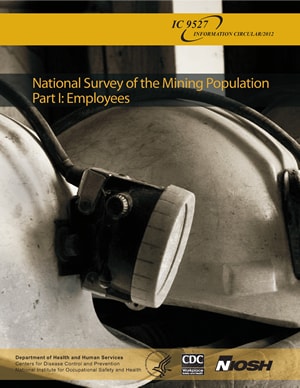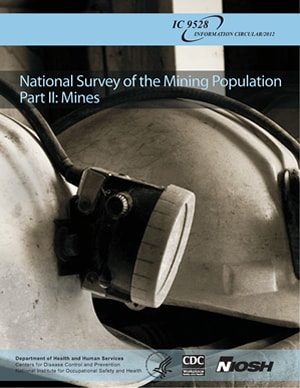Mining Feature: New National Survey of the U.S. Mining Population Published
Friday, December 14, 2012

Part 1: Employees
The most comprehensive survey of our nation’s mining population has just been released, providing a current snapshot of this segment of the U.S. workforce. The “National Survey of the Mining Population” represents a major effort to design and conduct a survey of this type with the result of bringing the mining workforce and mining operations into sharper focus. Prior to this survey, certain aspects of the mining population were not previously included in surveys—such as the job activities of contractor employees in mining.
It has been more than 20 years since publication of the last survey of the U.S. mining population. The last mining survey was conducted in 1986 by the U.S. Bureau of Mines. The new national survey, conducted in 2008 by the National Institute for Occupational Safety and Health (NIOSH) Office of Mine Safety and Health Research (OMSHR), is now published in two NIOSH Information Circulars (IC 9527 and IC 9528).
Questionnaires were sent to randomly selected mining operations in the five major mining sectors (coal, metal, nonmetal, stone, and sand and gravel). A total of 737 mining operations returned completed questionnaires and reported data for 9,008 employees.
The overarching goal of the new survey is to improve NIOSH’s surveillance capability related to the occupational risks in the mining industry. The specific aims of the survey were to: (1) understand the demographic and occupational characteristics of mine operator employees, (2) obtain denominator data for at-risk population subgroups, (3) obtain mine-level information on selected variables, and (4) estimate the number of independent contractor employees in mining and the type of work they perform.
NIOSH’s surveillance of the mining population will provide up-to-date data on mine workers currently working in the five major sectors of the U.S. mining industry. Also, survey results will be used to guide mining research and training programs for workers in various mining occupations. According to Linda McWilliams, Principle Investigator of the national survey project, “With denominator data now available, it will be possible to calculate injury rates for various demographic groups (gender, mining experience) and occupations (roof bolters, electricians). This will allow the customization of safety and health interventions for specific subgroups of mine workers to help improve their working conditions.”

Part 2: Mines
The new National Survey report includes two volumes, “Part I: Employees” and “Part II: Mines,” which represent the two sets of data collected from the survey respondents. The information presented in “Part I: Employees” summarizes demographic and occupational characteristics of employees in the U.S. mining industry including employee gender, age, level of education, ethnicity, race, job experience, primary work location, and occupational categories.
The “Part II: Mines” portion of the survey includes mine-level data related to employee training; training materials and methods; frequency of safety training; work schedules; shift work schedules; job activities of independent contractor employees; communication devices and systems; personal locators, trackers, and devices; emergency early warning methods; and information on mine rescue teams.
These two volumes now bring the current mining workforce and mining operations into sharper focus, and enable OMSHR researchers to better target health and safety goals. Going forward, detailed national surveys of this type should prove helpful in pinpointing the demographic and occupational characteristics of the current mining workforce and will contribute significantly to NIOSH’s research efforts in making U.S. mining operations safer work environments.
- Announcing New Publication on Refuge Alternatives
- Health Conditions in Retired Manual Labor Miners and Oil and Gas Extraction Workers: National Health Interview Survey, 2007-2017
- I Can't Get Enough Air! Proper Self-contained Self-rescuer Usage
- National Survey of the Mining Population: Part I: Employees
- National Survey of the Mining Population: Part II: Mines
- Pillar Stability Issues Based on a Survey of Pillar Performance in Underground Limestone Mines
- Refuge Chamber Training Products and Guidance
- Review of Recent Research on Organizational and Behavioral Factors Associated With Mine Safety
- Task Analysis
- Teaching Miners: Breaking the Barriers to Learning
- Technology News 535 - NIOSH Releases New Educational Video: Escape from Farmington No. 9: An Oral History
- Technology News 537 - NIOSH Develops New Mine Refuge Chamber Training